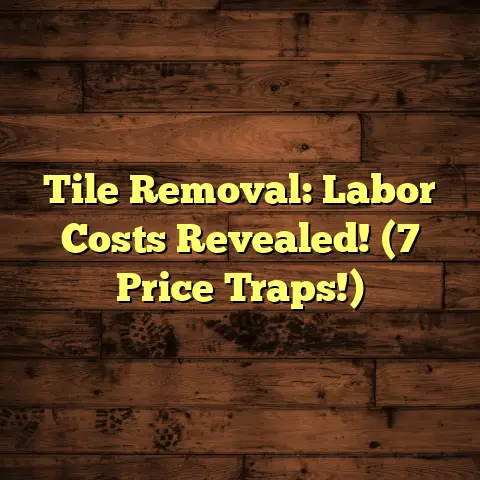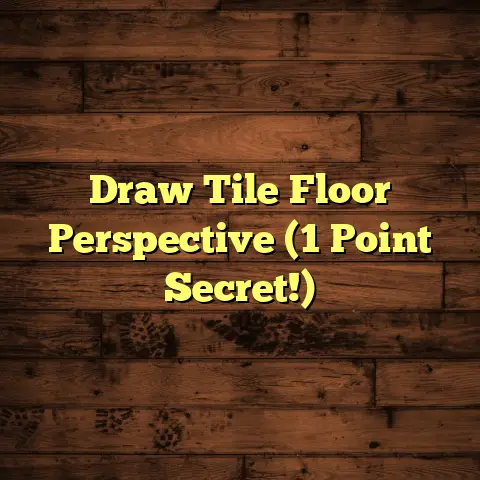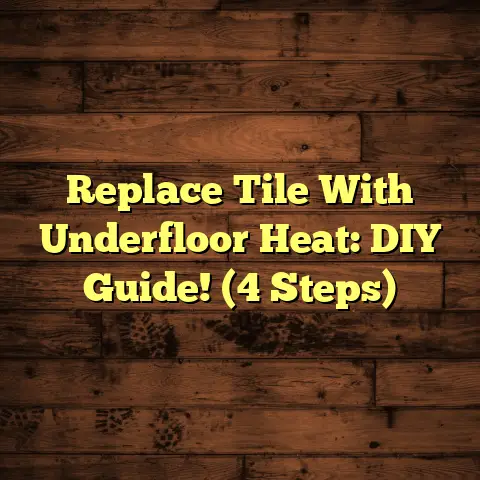Remove Tile Glue From Floors? (1 Tool You Must Have!)
The One Tool You Must Have!
Ever ripped up old tiles, feeling that sweet satisfaction of a job well done, only to be confronted by… that? Yeah, I’m talking about that rock-hard, cement-like residue that just laughs at your scraper.
Have you ever found yourself staring at that stubborn tile glue, wondering how on earth you’re going to remove it without damaging your floor? What if I told you there’s one tool that could make this tedious task not only manageable but also surprisingly efficient?
I’ve been there, knee-deep in adhesive nightmares. It’s enough to make you question all your DIY choices! But trust me, there’s a light at the end of the tunnel. Removing tile glue can be a real bear, but with the right approach and, more importantly, the right tool, you can conquer that sticky situation without turning your project into a demolition derby.
Let’s dive in and get that floor smooth and ready for its new life!
Section 1: Understanding Tile Glue
So, what exactly is this stuff that’s holding your floor hostage? Tile glue, more formally known as tile adhesive or mortar, comes in a few different flavors. Knowing which one you’re dealing with is half the battle.
-
Thin-Set Mortar: This is your workhorse adhesive. It’s a cement-based powder that you mix with water or a latex additive. It’s strong, durable, and used for most tile installations. Think of it as the “general purpose” glue.
-
Mastic: Mastic is a pre-mixed adhesive, often used for wall tiles or backsplashes. It’s easier to apply than thin-set, but it’s not as water-resistant or strong. I’ve seen it used on floors, but it’s generally not recommended, especially in wet areas.
-
Epoxy Mortar: This is the heavy-duty stuff. Epoxy mortar is a two-part system that creates a super strong, chemical-resistant bond. You’ll find it in commercial kitchens, hospitals, and other demanding environments. It’s also the toughest to remove.
Why is tile glue so darn hard to remove? A few factors are at play:
-
Adhesion: Tile adhesives are designed to stick. They chemically bond to both the tile and the substrate below. The longer it’s been there, the stronger that bond becomes. Think of it like a super-strong friendship. The longer you’ve known each other, the harder it is to break apart.
-
Surface Porosity: Porous surfaces like concrete provide a ton of tiny nooks and crannies for the adhesive to grab onto. The more porous the surface, the more difficult it is to remove the glue cleanly.
-
Type of Adhesive: As I mentioned earlier, epoxy mortar is significantly harder to remove than mastic. Knowing what you’re dealing with will dictate your approach.
I remember one job where I was hired to replace some old ceramic tile in a bathroom. The homeowner had attempted to remove the tile themselves but gave up after spending an entire weekend battling the adhesive. It turned out they were dealing with a particularly stubborn epoxy mortar.
They had tried everything – scrapers, hammers, even a chisel! The floor was a mess, and they were exhausted. That’s when they called me in. With the right tools and techniques (which I’ll get to later!), I was able to remove the remaining adhesive and prep the floor for the new tile in a single day.
The moral of the story? Don’t underestimate the power of tile glue! Understanding what you’re up against will save you time, frustration, and potentially a lot of money.
Section 2: The Importance of Choosing the Right Tool
Okay, so you know what tile glue is and why it’s such a pain. Now let’s talk tools. Using the wrong tool for the job is like trying to cut a tree down with a butter knife. You might eventually get there, but you’ll be exhausted and probably ruin the butter knife in the process.
There’s a whole arsenal of tools that people try to use for tile glue removal. Let’s break down some of the common contenders:
-
Hand Scrapers: These come in various sizes and shapes. They’re good for removing small amounts of loose adhesive, but they’re not very efficient for large areas or stubborn glue. Think of them as the “starter tool.”
-
Putty Knives: Similar to hand scrapers, but often with a more flexible blade. They’re better for getting under thin layers of adhesive, but they’re not strong enough for thick, hardened glue. I usually keep these around for touch-ups and small areas.
-
Heat Guns: Applying heat can soften some adhesives, making them easier to scrape away. However, heat guns can also damage certain flooring materials, like vinyl or wood. Plus, they can release fumes from the adhesive, so proper ventilation is crucial.
-
Solvents: Chemical solvents can dissolve some types of tile glue. However, they can also be harsh, toxic, and require careful application and ventilation. Always test a small, inconspicuous area first to make sure the solvent doesn’t damage your flooring. I usually reserve these for very stubborn spots after trying other methods.
-
Grinders with Diamond Blades: These are powerful tools that can grind away tile glue quickly. However, they also generate a lot of dust and can easily damage the underlying floor if you’re not careful. I’ve seen DIYers gouge their concrete slabs beyond repair using these.
-
Chisels and Hammers: This is a brute-force approach. While it can work, it’s also incredibly labor-intensive and carries a high risk of damaging the floor. I only recommend this as a last resort for small, isolated spots.
So, with all these options, which one reigns supreme? Which tool will actually make your life easier and your floor look amazing?
Keep reading… the answer is coming!
Section 3: The One Tool You Must Have
Alright, drumroll please… the one tool you absolutely must have for removing tile glue from floors is…
A High-Quality Floor Scraper with a Long Handle and Replaceable Blades!
I know, it might not sound as exciting as a laser beam or a magic wand, but trust me, this tool is a game-changer. I’m talking about a scraper specifically designed for flooring removal, not just a regular hand scraper you’d find at the hardware store.
Here’s what sets a good floor scraper apart:
-
Long Handle: The long handle allows you to apply leverage and work from a standing position. This saves your back and knees, especially on large projects. I’ve used short-handled scrapers before, and let me tell you, my back paid the price!
-
Heavy-Duty Construction: A quality floor scraper is built to withstand the rigors of tile glue removal. Look for one made from sturdy steel with a comfortable grip. You don’t want it bending or breaking halfway through the job.
-
Replaceable Blades: This is crucial. Blades dull quickly when scraping tile glue. Being able to easily replace them ensures you’re always working with a sharp edge, making the job faster and more efficient. Plus, replaceable blades are much more cost-effective than having to buy a new scraper every time the blade dulls.
-
Adjustable Blade Angle: Some floor scrapers allow you to adjust the angle of the blade. This is helpful for different types of adhesive and flooring surfaces.
Why is a floor scraper so effective? It combines leverage, a sharp blade, and a comfortable design to make quick work of even the most stubborn tile glue. You can apply consistent pressure and effectively shear away the adhesive without gouging or damaging the floor.
I’ve used countless tools over the years, but I always come back to my trusty floor scraper. It’s reliable, efficient, and saves me a ton of time and effort.
Don’t just take my word for it. I was chatting with a fellow flooring contractor, Sarah, the other day, and she said the same thing.
“A good floor scraper is worth its weight in gold,” she told me. “I used to dread removing tile glue, but now it’s just another part of the job. It’s all about having the right tool.”
Another contractor, Mark, shared a similar sentiment: “I’ve tried everything – grinders, solvents, you name it. But nothing beats a floor scraper for getting a clean, smooth surface.”
So, if you’re serious about removing tile glue efficiently and effectively, invest in a quality floor scraper. It’s the one tool you won’t regret having in your arsenal.
Section 4: Step-by-Step Guide to Removing Tile Glue
Okay, you’ve got your floor scraper. Now let’s get to work! Here’s a step-by-step guide to removing tile glue like a pro:
Step 1: Gather Your Materials
Before you start, make sure you have everything you need:
- Floor Scraper: The star of the show!
- Replacement Blades: Keep a few on hand.
- Hammer (Optional): For extra stubborn spots.
- Dust Mask: Protect your lungs from dust and debris.
- Safety Glasses: Protect your eyes from flying particles.
- Gloves: Protect your hands from adhesive and sharp edges.
- Shop Vacuum: For cleaning up dust and debris.
- Plastic Sheeting and Tape: To protect surrounding areas.
- Solvent (Optional): For particularly stubborn adhesive. Make sure it’s compatible with your flooring.
Step 2: Prepare the Area
-
Clear the Room: Remove all furniture and other obstacles from the area.
-
Protect Surrounding Areas: Cover any adjacent flooring or walls with plastic sheeting and tape to prevent damage.
-
Ventilate the Room: Open windows and doors to provide adequate ventilation, especially if you’re using solvents.
Step 3: Start Scraping
-
Position the Scraper: Place the blade of the scraper at a low angle to the floor. You want to get under the adhesive, not dig into the floor itself.
-
Apply Pressure: Use your body weight to apply consistent pressure to the scraper handle.
-
Push Forward: Push the scraper forward in a smooth, controlled motion. You should see the adhesive start to shear away from the floor.
-
Replace the Blade: When the blade starts to dull, replace it with a fresh one. A sharp blade is essential for efficient removal.
Step 4: Tackle Stubborn Spots
-
Hammer and Scraper: For particularly stubborn spots, you can use a hammer to tap the scraper blade. This will help to break the bond between the adhesive and the floor. Be careful not to hit the floor directly with the hammer.
-
Solvent Application: If the hammer and scraper aren’t enough, you can try applying a solvent to the adhesive. Follow the manufacturer’s instructions carefully and always test a small, inconspicuous area first. Let the solvent sit for the recommended time, then try scraping again.
Step 5: Clean Up
-
Vacuum the Area: Use a shop vacuum to thoroughly clean up all dust and debris.
-
Inspect the Floor: Check the floor for any remaining adhesive or damage. Repeat the scraping process as needed.
-
Clean with Solvent (Optional): If there’s still a thin layer of adhesive residue, you can try cleaning the floor with a solvent. Again, make sure it’s compatible with your flooring.
Safety First!
-
Always wear a dust mask, safety glasses, and gloves to protect yourself from dust, debris, and sharp edges.
-
Work in a well-ventilated area, especially when using solvents.
-
Be careful when using a hammer and scraper to avoid damaging the floor.
-
If you’re not comfortable using power tools, consider hiring a professional.
By following these steps, you can effectively remove tile glue from your floors and prepare them for their next chapter!
Section 5: Troubleshooting Common Issues
Even with the best tools and techniques, you might encounter some challenges along the way. Here are some common issues and how to troubleshoot them:
-
Stubborn Glue Residue: Sometimes, even after scraping, a thin layer of glue residue remains. This is especially common with epoxy mortars.
- Solution: Try using a solvent specifically designed for removing epoxy. Apply it according to the manufacturer’s instructions and let it sit for the recommended time before scraping again. You can also try using a slightly more aggressive scraper blade.
-
Damage to Flooring: If you’re not careful, you can easily gouge or scratch the underlying floor. This is especially true with softer flooring materials like wood or vinyl.
- Solution: Use a lower angle on the scraper blade and apply less pressure. If you do accidentally damage the floor, you may be able to repair it with wood filler or patching compound. In severe cases, you may need to replace the damaged section of flooring.
-
Tool Malfunction: Floor scrapers are relatively simple tools, but they can still malfunction. The blade can break, the handle can loosen, or the adjustment mechanism can fail.
- Solution: Regularly inspect your floor scraper for any signs of wear or damage. Replace worn blades promptly. Tighten any loose screws or bolts. If the tool is irreparable, replace it with a new one.
-
Dust and Debris: Removing tile glue generates a lot of dust and debris. This can be a nuisance and can also pose a health hazard.
- Solution: Wear a dust mask and safety glasses to protect yourself from dust and debris. Use a shop vacuum to regularly clean up the area. You can also try wetting the adhesive before scraping to reduce dust.
-
Adhesive Type Unknown: Sometimes, you might not know what type of adhesive you’re dealing with. This can make it difficult to choose the right removal method.
- Solution: Try testing a small, inconspicuous area with different solvents. If one solvent works better than the others, you can assume that it’s the right one for the job. You can also try contacting a flooring professional for assistance.
Maintaining Your Floor Scraper
To keep your floor scraper in top condition, follow these tips:
-
Clean the Blade: After each use, clean the blade with a wire brush to remove any adhesive residue.
-
Sharpen the Blade: If the blade becomes dull, sharpen it with a file or grinding wheel.
-
Lubricate Moving Parts: Occasionally lubricate any moving parts with a light oil.
-
Store Properly: Store the floor scraper in a dry place to prevent rust.
By addressing these common issues and maintaining your floor scraper, you can ensure a smooth and successful tile glue removal project.
Section 6: Conclusion
So, there you have it! Removing tile glue from floors can be a challenging task, but with the right tool and techniques, it’s definitely achievable. Remember, the one tool you absolutely must have is a high-quality floor scraper with a long handle and replaceable blades.
This tool, combined with the step-by-step guide and troubleshooting tips I’ve shared, will empower you to tackle your tile glue removal project with confidence. You’ll save time, effort, and potentially a lot of money by doing it yourself.
Don’t be intimidated by that stubborn adhesive. Embrace the challenge, arm yourself with the right tools, and get ready to transform your floors!
Are you ready to say goodbye to that sticky mess and hello to a beautifully smooth, clean floor? Go get that floor scraper and make it happen! What are you waiting for? Your dream floor is just a few scrapes away!





